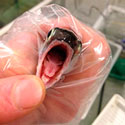3D scans map widespread fish disease

Enteric redmouth disease is a bacterial infection that can kill fish, but is entirely harmless to humans. Symptoms typically take the form of a redness or bleeding in and around the mouth of the fish.
“The new scans show us that the fish are infected through their ultra-thin gills,” explains postdoc Maki Otani, the Department of Veterinary Disease Biology, Faculty of Health and Medical Sciences.
Educated in Japan, Maki Otani has supervised the scanning process, where advanced technology and precision combine to form a higher synthesis. For this reason, the research group can now map with extreme precision the bacterial infection (Yersinia ruckeri) causing enteric redmouth disease in fish.
The disease, which reduces fish well being and increases fish mortality in Danish fish farms, is harmless to humans.
The researchers have scanned the ultra-thin gills of rainbow trout. The gills are a specialised organ whose chief function is to absorb oxygen from the water so the fish can breathe. Only two cell layers separate the outer water from the blood in the fish’s small arteries. The new findings show that the bacterium infects the fish via a specific cell type in the gills.
As little as 60 seconds after the bacterium is introduced into the aquaculture, its presence can be registered in the fish’s bloodstream. The bacterium subsequently infects the fish via its intestine and the lateral line canal– a sensory apparatus running along both sides of the body.
The University of Copenhagen possesses a so-called OPT scanner (Optical Projection Tomography) – a rare piece of equipment enabling researchers to monitor the infection with unparalleled precision.
“The research findings are presumably the first of their kind and the scanning images exceed our wildest dreams,” explains associate professor Martin Raida, the Department of Veterinary Disease Biology, who is heading the project.
Among other things, he is conducting research in developing vaccines. The Danish fish production industry currently vaccinates its fish, also against enteric redmouth disease, but to date this has not solved the problem. Martin Raida hopes that the new knowledge can contribute to the development of a more effective vaccine against enteric redmouth disease. This will contribute to bring down the amount of antibiotics used and thus reduce the burden on the environment.
Maki Otani, mobile: + 45 42 46 88 82
Martin Raida, mobile: + 45 60 66 67 01
Media Contact
All latest news from the category: Agricultural and Forestry Science
Newest articles

Superradiant atoms could push the boundaries of how precisely time can be measured
Superradiant atoms can help us measure time more precisely than ever. In a new study, researchers from the University of Copenhagen present a new method for measuring the time interval,…

Ion thermoelectric conversion devices for near room temperature
The electrode sheet of the thermoelectric device consists of ionic hydrogel, which is sandwiched between the electrodes to form, and the Prussian blue on the electrode undergoes a redox reaction…

Zap Energy achieves 37-million-degree temperatures in a compact device
New publication reports record electron temperatures for a small-scale, sheared-flow-stabilized Z-pinch fusion device. In the nine decades since humans first produced fusion reactions, only a few fusion technologies have demonstrated…





















